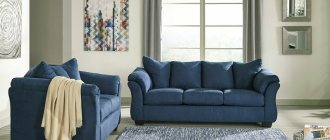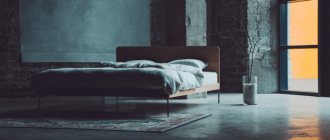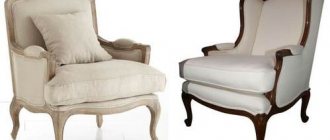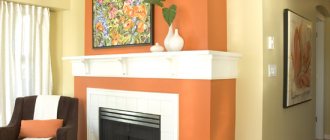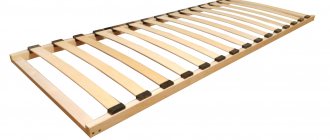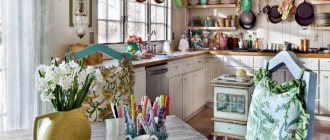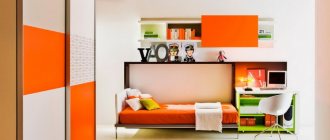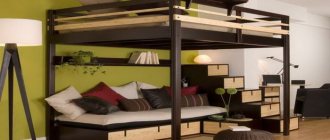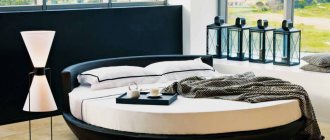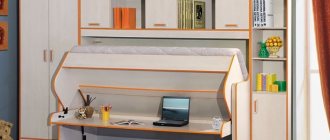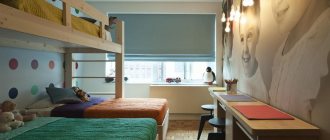Materials and tools
What you will need to make capitone
First, you should purchase all the necessary material and prepare the tool. Materials for production:
- The plywood will act as a base, it all depends on what it will be - the sides or head of the bed, the wall.
- Foam rubber corresponding to the shape and size of plywood and having a thickness of 5 cm.
- Fabric/leather/eco leather is 0.5 m wider and longer than plywood, add 30 cm for buttons if you have to cover them. The amount of material depends on the pattern report; the smaller it is, the greater the consumption, and vice versa.
- Metal buttons.
- Glue for foam rubber.
- A piece of padding polyester that follows the shape of foam rubber and plywood. They need to be covered with foam rubber.
Tools you will need:
- furniture stapler, preferably pneumatic;
- cord for fastening buttons;
- crochet hook;
- sharp knife;
- drill for drilling holes in plywood;
- drill with Ziefendorf attachment.
Screed manufacturing processes are completed in a matter of minutes if you have a special tool. You can learn about the principle of its operation and features from the video we offer.
Materials and accessories
When making a bed using the carriage screed technique, the choice of upholstery material, backing and fittings is crucial. The lifespan of the finished product will depend on their quality, so you shouldn’t skimp on them. For upholstery, high-quality, durable fabric with high density is suitable. The technique involves strong tension, so the thin material will quickly fail. The fabric should be plain. If you choose a small pattern, its lines will be distorted by the screed, and the appearance of the product will be ruined.
Tips for making a headboard with your own hands, installation nuances
What materials are suitable for upholstery:
- Genuine Leather. Durable, wear-resistant material, the disadvantages include high cost.
- Chenille. Durable, wear-resistant material.
- Faux leather. It holds wrinkles well, is wear-resistant, but is inferior in durability to natural fabric.
- Flock. Nice soft pile fabric with a large selection of colors.
- Velours. Velvet material, with its help deep folds are obtained well.
- Jacquard. Luxurious fabric with a large pattern. Products with it look expensive.
The beauty of the design depends entirely on the soft lining. Synthetic padding polyester and foam rubber with a thickness of five to eight centimeters are most often used as a substrate. The depth of the screed will depend on its density, which will affect the appearance of the finished product. You will also need cords or threads to tighten the buttons. They must be durable, the thickness can be selected individually, depending on the screed technique.
The capitonné is decorated with decorative buttons or furniture nails. They can be complemented with bright rhinestones or covered with matching upholstery fabric. The choice depends on the design of the room where the bed will be placed.
It is important to pay attention to the stem of the button; it must be made of metal. The plastic one will not withstand heavy loads and will quickly break off.
Genuine Leather
Chenille
Faux leather
Flock
Velours
Jacquard
Instructions for action
Drill holes using a drill.
It is very important to note that the panel on which it is planned to create the carriage screed is created separately from the wall. As a basis, you can use a wide variety of materials, which are sheets
It can be plywood, chipboard and MDF. The panel must be adjusted to the required dimensions, after which a sheet of foam rubber is glued to it. The use of nitro glue for these purposes is absolutely unacceptable, since it has the property of corroding the entire material. In this regard, it is best to use rubber glue, which is based on rubber. The glue must be applied to the panel and to the foam in 2 layers. It must be taken into account that the next layer of glue must be applied only after the first layer is completely dry. After applying the second layer, the foam is securely attached to the panel (this may require 6 hours); design templates, which are made using thick paper, must be applied to the materials. Holes are cut out on the template, they need to be drawn with a pencil on the foam rubber surface. Then you need to mark places on the material, drill holes with an appropriate tool (the tool should have one or two cutting blades). When all the holes are prepared, the foam rubber must be covered with padding polyester. Where there are holes in the foam rubber, you need to make holes in the padding polyester. After this, the resulting structure should be covered with a pre-selected material, which also needs to be secured to the inside of the panel with a stapler. The material must be stretched with maximum evenness, there should be no folds, but compression should also not be allowed.
We stretch the fabric and use a drill to drill holes in it.
Share on
Beautiful furniture can decorate any interior and create a cozy atmosphere even with simple wall decoration. In the bedroom, a bed with a carriage frame looks chic and emphasizes the sophistication of the chosen style. Considering the rather high cost of the finished product, a volumetric headboard can be made independently at home. The bed will become a real highlight of the room; it will look cozy, rich and elegant.
The carriage screed has been known for quite some time. Back in the mid-19th century, expensive carriages were decorated in this way. The screed symbolized prosperity and luxury. This decoration method was used mainly for royal luxury items. Capiton (as carriage screed is also called) has also found application in the design of walls and upholstered furniture. The most famous example made using this technique is the classic Chesterfield sofa or Karelia bed 160x200.
After some time, capitone lost its popularity. However, recently such decor has come back into fashion. Modern apartments are decorated using this technique. These can be walls, chairs, headboards, and many other interior items. Furniture with a carriage frame looks elegant and cozy. Some people believe that such beds can only be suitable for classic style. But products made using this technique will fit perfectly into modern, pop art, kitsch and modern room design.
You can choose a bed with a carriage frame in a furniture showroom, or you can decorate the headboard of the bed yourself. This does not require special knowledge; a novice master can do it. A little effort and patience will do the trick. The bed will be transformed and will look elegant. Before starting work, you need to decide which type of capitonné decor is suitable.
There are several types of carriage screed:
- Diamond-shaped;
- Square;
- Complex, with changing geometry.
Expensive, beautiful material, as well as buttons, rhinestones, crystals, and LEDs give the furniture a special chic and elegance.
Design and combination with the interior
A bed with a soft carriage frame will add coziness to a bedroom with any interior and will be the main decoration there. The headboard can be a separate element and attached to the wall or form a single structure with the bed frame, made using the same technique. The colors are selected depending on the dominant color of the room, as well as the overall design. Beds with a carriage frame will fit perfectly into the following interior styles:
- Baroque. A pompous style, characterized by luxury and bright, rich colors. The back of the headboard must be in a curved massive frame, with a pattern. It is better to choose upholstery in blue, deep wine-colored velvet.
- Empire style The ideal bed would be a cream or beige color with a backrest in a gilded frame, with forged elements.
- Classic. Preference should be given to beds in white or light beige. The fittings must be upholstered in the main fabric. A little gilding on the back will add luxury and solemnity.
- Modern. A bed with a high back and rounded corners of the headboard is suitable. It is better to choose a calm, neutral color, focusing on the overall tone of the room.
Causes of bed squeaking, how to fix it and what to do for prevention
There are rules that all manufacturers of upholstered furniture with carriage screed adhere to:
- For a headboard with right angles, use a square or rectangular screed.
- For backs with curved lines, irregular or rounded shapes, the diamond-shaped technique is used.
It doesn’t matter which bed made using the capitonné technique you choose. Any of them will look decent in the interior, become its decoration, and add coziness and comfort. And for those who did not plan to change the furniture in the near future, there is the possibility of making a removable cover for the headboard, made using the carriage tie technique. Moreover, it is easy to do it yourself.
Baroque
Empire style
Classic
Modern
What is a carriage screed and what types are there?
Carriage screed is a finishing technique that is also commonly called “capitone”. It appeared back in the 18th century; it was used in France to decorate carriages, and such design was considered a sign of luxury. In those days, not only vehicles, but also interior items in the homes of aristocrats were decorated with such equipment.
Despite the fact that the carriage screed has lost its former popularity for some time, the technique is now actively used by designers in their projects. That is why it can be found in many modern apartments. Furniture decorated in this way looks very elegant.
Interior with elements of carriage screed
It is worth noting that over several centuries, “capitone” has undergone significant changes - new unusual ways of using this technique began to appear.
Table No. 1. Types of carriage screed
| View, illustration | Description |
| Diamond-shaped | The pattern is a repetition of diamonds of the same size. Beginners in this business are recommended to opt for the standard version of rhombuses, because creating figures with sharp ends requires some experience from the master. |
| Square | In this case, the design looks like a square. It should be noted that this form is most optimal for beginners in this business, because working with straight lines is much easier. |
| Unusual geometric shapes | Professional craftsmen make screeds of various shapes, create curly headboards and rounded patterns. You should not immediately choose such a design; it is better to start learning the craft with a simpler ornament. |
To fix the material in this technique, buttons of various diameters and nails with voluminous heads are used. They will first need to be covered with the same material or purchased to match the main material.
Decorating furniture with a carriage screed has the same principle, but there are still some differences in the execution technology
It is necessary to choose the most convenient option, because here it is the outcome that is important
Finishing using carriage screed technology is carried out in two directions:
- the workpiece is covered with material exactly according to its size, and only then an ornament is formed on the surface;
- The upholstery of the base is done using small pieces of textile or leather of the required size.
Advantages of carriage screed
The popularity of "capiton" for several centuries is due to the following advantages:
- A headboard or chair designed using this technique will be very soft and therefore comfortable.
- Such a surface does not require any special care, even if textiles rather than smooth leather are used for upholstery. You only need to periodically use a vacuum cleaner to remove dirt from the product.
- Even after many years of use, a high-quality carriage screed does not lose its original appearance.
- If over time there is a desire to replace the coating (the fabric is outdated, greasy marks have appeared), then this can be done while maintaining the integrity of the soft base. In addition, if necessary, you can restore the panel by adding only a piece of material in a certain place.
- This technique can be used to decorate almost any surface, giving it an unusual decorative look.
- Pieces of furniture with such upholstery are suitable for decorating both respectable interiors and small apartments, that is, they are completely universal.
- This is an excellent opportunity to insulate the wall and improve the level of sound insulation.
- The walls that are supposed to be decorated with a carriage screed can be leveled strictly to the level.
Carriage screed on furniture: technical features
The main feature of the technique is rivets, buttons or rhinestones, with the help of which the upholstery material is attached to the backing. Filler is added between layers to add volume.
Another highlight of the technique is the location of the fixation points at the same distance from each other. The result is a beautiful geometric pattern.
Furniture upholstered with carriage screed
Important! This technique is used on different materials. The decor looks especially impressive on leather, velor, and suede. The color of the material does not matter - the upholstery can decorate light, bright and dark surfaces.
Making a template
The success of the event as a whole will largely depend on the correctness of the pattern, so care and accuracy are important when making it.
For the template, take a sheet of cardboard that matches the dimensions of the finished product. The easiest way is to draw a square marking of standard sizes 10x10 cm.
To obtain such markings, you need to apply marks along the length and width every 10 cm using a marker and tape measure, then draw horizontal and vertical lines
When choosing the geometry and size of figures, it is important to maintain proportional compliance
To obtain a geometric pattern in the form of a rhombus, you can use a surface marked into squares. In each square you need to draw its diagonals.
The intersections of the diagonals of the squares and the vertices are marked with a felt-tip pen so that the required geometric figure is obtained. Trace the resulting diamonds with a marker or felt-tip pen.
Holes are cut out at the tops of the diamonds through which buttons or furniture nails will be attached in the future.
GLUING FOAM RUBBER TO ELEMENTS:
First, let's start gluing the foam rubber onto the bed frames.
The glue was applied with a brush, it is very fast, everything sticks quickly. The top layer of glue dries almost instantly, you can’t just smear the entire drawer with glue and glue the foam rubber until you get to the end - at first the glue has already dried, you have to glue it gradually. First we glue 40mm foam rubber and cut off the edges with a construction knife.
Then, from above, going to the ends of the drawers, we glue 15 mm foam rubber:
Let's move on to the headboard.
First, we need to draw a drawing of our carriage screed. We draw lines, mark points, draw diagonal lines, and we get our diamonds. I immediately mark the locations of future holes at the vertices of the rhombuses with circles, so that later I don’t have to think about it when drilling.
Drill holes with a 10 mm drill:
A layer of 80 mm foam rubber was laid on the headboard, consisting of two layers of 40 mm each. Glue the first layer:
In the upper part of the headboard, mark with a marker the longitudinal lines from the top and front sides of the foam rubber (25-30 mm from the edges), and cut off the upper edge of the foam rubber:
We glue the second layer of foam rubber, place it on the upper part of the headboard and shoot it with a stapler from the back side:
After the foam is completely glued to the top of the headboard, cut off the excess foam exactly along the edge:
And cut off the top edge, as with the first layer on the front side:
We glue 15 mm foam rubber onto the sides of the headboard and cut it according to the shape:
In the lower part, I cut the foam rubber at an angle with a construction knife, it turned out very scary:
Subsequently, before covering the lower part, I made a long knife from canvas, an aluminum plate and rivets, and then cut it straight:
Before covering it with artificial leather, it was necessary to refine the open plywood surfaces of the drawers and lintels, so it was decided to cover them with acrylic varnish, which was left over from making cabinets in the workshop:
All connecting and supporting elements of the bed were also varnished:
Carriage screed technology
At first glance, the carriage screed technology is elementary. But like any labor process, it hides a lot of nuances, and the advice of furniture makers can be very useful:
Start work with a plan-drawing. The dimensions of the product provide information about the need for material, and it is better to take it with a reserve. If the screed is being made for the first time, then it would not be amiss to make a small banquette, upholstery of a chair or bench, and even a sofa cushion - experience will reveal all the mistakes. The size of the first item should not be chosen on a grand scale - 0.5 * 1.0 m is enough.
The screed is performed with considerable mechanical effort, and the base (plywood, less often thick cardboard) must be strong. The lining layer must also be durable, but at the same time elastic and soft. It is difficult to select the thickness of the required base by eye; everything is revealed in the work. A sample will always help you determine the stitching interval and the thickness of the lining layers.
In order for the marking on the foam sheet to be accurate, you must first mark a sheet of cardboard similar in size to the panel being lined.
A foam pad is glued to the rigid base using a special composition. Glue in aerosol cans is much more convenient. Holes should be drilled in a glued piece of plywood and foam rubber only after the glue has completely dried.
Fabric for carriage screed
Covering fabrics are selected according to the criteria of strength and density. Thin materials and plain weave can present an unpleasant surprise - at local points of puncture of the fabric and future fastening with furniture nails, tears and tracks are possible, the fabric “creeps”. For the same reason, knitwear is not suitable. The overall impression and reliability of the product depends on the quality of the finishing cladding. Plain fabrics are a classic for carriage ties, but small patterns, stripes and textured fabrics are also interesting. The main thing is that the fastening step matches the drawing. But choosing printed upholstery is a rarity when it comes to making carriage ties.
Buttons for carriage ties
The button for the tie can be figured, not necessarily plain with upholstery; there are options with rhinestones and flower decor, with precious stones and coins. Screed fastening details are chosen in harmony with the idea of the interior. Carriage ties are available in various styles, and with a skillful approach they can decorate even a strict or high-tech style.
Lining for carriage screed
Often, thermal insulation made of foamed polyethylene is placed under the foam rubber sheet for strength and deep relief of the product. Furniture padding polyester is also suitable; such upholstery turns out to be exceptionally delicate and soft, and at the same time with a clearly defined high relief.
Completion of work on carriage screed
Before fixing the upholstery to the base, the materials are carefully smoothed, each fold is formed separately. The work is painstaking and requires accuracy, but otherwise a beautiful and high-quality screed cannot be completed. The slightest misalignment will be difficult to eliminate, and deformations, barely noticeable at first, usually appear during the use of the upholstery. During operation, each button is recessed into the base to the same height, with control. The geometry of the puff pattern must not be violated, otherwise the finishing will cause a feeling of sloppiness.
Work order
A sheet of foam rubber is glued onto the prepared base panel. The glue is applied in several layers both to the base and to the elastic lining. Typically, foam rubber sticks together quickly enough, but for the glue to dry completely, it is better to leave it for 5-6 hours. If several layers of lining are provided, each subsequent layer is glued only after the previous one has completely dried. After the foam sheet is completely glued, a cardboard template with a geometric pattern and holes is placed on the structure, and the holes on the template are drawn with a felt-tip pen or marker. Holes are cut in the marked places using a drill with a special Zifenbor attachment. On the plywood sheet, mark the points for the holes that coincide with those on the lining. This can be done using the same cardboard template. Holes are also made in the plywood sheet using a drill, but of a smaller diameter. It should allow you to insert a crochet hook. The diameter of such holes is comparable to the thickness of a match. After cutting the holes, a padding polyester lining is glued onto the foam sheet. Holes are also cut in it, coinciding with the previous layer. The resulting structure is covered with upholstery. It is attached to the plywood with a stapler along the outer edges on all sides. The upholstery is pulled smoothly and evenly so that it does not compress the foam-sintepon layer
It is important not to overtighten the fabric to avoid tearing it later. Hooks are inserted into all holes and their edges are brought out through small holes in the plywood sheet. After removing the hooks, cords (threads) of the required thickness are attached to them. On the front side of the structure, buttons are attached to each hook. The cords or threads are pulled from the wrong side, pressing in the upholstery fabric. It is necessary to ensure that the buttons are installed at the same depth, and the upholstery is dented evenly
The folds are formed by hand. On the reverse side of the structure, the cords are secured with a stapler. For stable fastening, it is better to choose a zigzag option.
When using it, time and labor costs are reduced several times. The order of work, in this case, is as follows:
- A base is prepared from sheet material, given the desired shape and sanded.
- Foam rubber and padding polyester are glued to the base using high-quality glue.
- Holes are made in the foam-sintepon layer.
- Upholstery material is attached on one side.
- The attachment points are marked on it.
- Using a gun, holes are punched and buttons are inserted along with a holder securing them on the back side.
When working with an air gun, it is enough to choose the right consumables and follow the instructions for use.
Capitone with the use of special carnations provides additional opportunities for decoration. Carnations with brass and bronze caps decorated with rhinestones will add originality and sophistication.
To finish capitonné using nails, you can choose the following work option:
- Prepare the base, glue foam rubber and padding polyester.
- Mark the nail locations using a template.
- To ensure durability of the fastening and to avoid tears in the fabric, stretchers are used between the nails of the same material as the upholstery.
- Mark the attachment points on the upholstery.
- Attach the upholstery cover.
- Carefully drive in the nails along with the stretch marks between them.
Where is this type of screed used?
Today, carriage screed has conquered interiors all over the world; it is used to decorate walls, armchairs, headboards, all kinds of poufs and couches. Its classic look will complement any modern design style.
It is not difficult to make, but it requires enough strength and dexterity to tighten the buttons or hammer in special nails, which, when pressing the foam rubber, create an interesting geometric pattern, most often square, triangular or diamond-shaped.
If you want to decorate a wall or piece of furniture in this way, practice first. If you ruin a small piece of plywood, there won’t be much harm, but you will understand the principle of such a craft and gain practical experience.
The history of the appearance of carriage screed in the interior
An alternative name for the technique is capitone upholstery. The decorative technique received its name due to its similarity with the design of royal carriages. The creators were first inspired by the idea of a similar design of interior items back in the 18th century.
However, the technique reached its peak during the reign of Emperor Napoleon III. His chambers were furnished with quilted furniture that delighted elegance and luxury.
People liked the decor so much that they began filling their homes with items decorated with the quilt. Gradually, the trend spread beyond France and became popular throughout the world.
Carriage screed decor on furniture upholstery
Carriage screed - stages of work
First of all, the base is made to the required dimensions. This is done with a jigsaw or circular saw.
Then the plywood is marked using a strip and a marker. Depending on the width of the diamonds, dots are drawn along the long edges every 10 or 15 cm.
Opposite marks are connected by lines indented by one division so that they take a running start. Holes are drilled at their intersections.
At the same time, a full-size stencil is made from cardboard. You will need it later. Next, glue is applied to the entire surface using a roller and foam rubber is applied. Do not press it too hard so that it does not become saturated with the fixing compound - this will put an end to your work.
After drying, dots are also made on it with a pencil (the ink of the marker sometimes appears on the fabric). Using a Zifendorf nozzle, they drill holes the size of your buttons into the filler.
On top, stretching it very carefully (invite someone from your family to help), glue the padding polyester.
The most crucial moment is marking the material. On the cut, an indentation is made from the place of the first tightening to the edge of the base and another plus of 75 millimeters.
Expert opinion Maria Vasilievna Mikhailova Manager of a furniture store. Knows everything about comfort and interior design
A stencil is placed on the back of the fabric and dots are made with it. A piece of thread is threaded into each (through two punctures so that the material can be pulled to the plywood).
Work very carefully at this stage, especially if you have chosen thin, delicate textiles. The first row is crocheted through the plywood and each loop is nailed from the inside with a stapler.
By the way, take only stainless steel brackets for it. Upon completion of the first row, proceed to the next and so on.
The first row is crocheted through the plywood and each loop is nailed from the inside with a stapler. By the way, take only stainless steel brackets for it. Upon completion of the first row, proceed to the next and so on.
If you carried out all the manipulations correctly, then in the end you will get a beautiful surface with neat folds
It is important to work slowly and meticulously, otherwise it is difficult to avoid distortion and defects
Work always begins from the middle of the future composition - this approach will ensure uniform stretching of the material and eliminate excessive constriction. Only then will the entire product look as elegant as possible.
Diamond-shaped folds are best smoothed out with a stick or knitting needle after a whole row has been formed. Later this will no longer be possible. After this comes the turn of buttons. They are installed before the formation of end folds occurs. Next, the edge of the material is nailed to the plywood with a stapler. The corners are fixed last.
The described option is quite simple to implement, but looks extremely attractive from an aesthetic point of view. You can see from your own experience that the most time and effort is spent on the preparatory stage. Completing work is an easy task, not without its pleasure.
A good master class on carriage screed is shown in this video:
What should the screed be like?
Decorating with a carriage screed is used only if there are funds for it. Still, the fabric, which gives an unusually beautiful look to the interior or any kind of interior, is expensive due to its dense texture and high quality.
In addition, it is not easy to choose, because it needs to be in harmony with the general background of the room and have a pattern of medium brightness.
The color of the fabric for upholstery or any other item in the interior of the room can be absolutely anything.
But the design on it should be neutral, since immediately striking and contrasting images on the upholstery material spoil the appearance of the finished structure.
A carriage screed will look very elegant on furniture upholstered with a plain thick fabric, as proven by the capitonné making master class shown in the video.
Such upholstery material can tear and render the carriage screed unusable. Even the thickness of the elastic lining is of particular importance, because the geometry of the pattern on the fabric will be more embossed and luxurious if the elastic lining is dense.
When choosing carnations or buttons to decorate furniture or the interior with a carriage tie, you need to focus on the volume of the room and its design.
For example, it is best to attach furniture buttons to the upholstery material of a sofa in a large room.
But the most beautiful thing on furniture is decorative nails, which make the room feel luxurious and cozy.
The carriage screed is distinguished not only by its beautiful appearance, but also by its practicality. When decorating the walls with it, you can achieve additional sound insulation of the room.
Surfaces decorated with carriage screed are easy to care for. They acquire a finished look in terms of design and do not require the use of any accessories, which is proven by the presented photos.
Once you have the skill to tighten buttons or hammer in decorative nails, you can begin decorating the walls or headboard.
The finished creative work, which the master talks about in the video, will never cease to please the eye, as it is one of everyone’s favorite timeless classics.
So, carriage screed is used to decorate walls, armchairs, headboards, ottomans and couches. It's not that difficult to make if you practice on something first.
Still, attaching buttons or nails that press the foam layer requires skill.
France is considered the birthplace of the carriage screed. Thus, in a modern interior, walls and various furniture in recreation rooms or bedrooms are decorated. Thanks to this finishing, the ceiling height visually increases and the room acquires an extraordinary style. For this finishing, eco-leather or fabric for upholstery is used. Let's look at step-by-step instructions on how to make a carriage screed yourself.
Additional decoration
Sometimes texture and geometry alone are not enough to achieve the effect desired by the decorator. In this case, for additional decoration of the carriage tie, all kinds of buttons, special buttons and even rhinestones are used. Here it is very important to feel the measure, know the features of lighting in the bedroom, and understand the properties of the fabrics used. Our craftsmen and designers are able to turn an ordinary bed into a real royal bed!
Are you interested in a carriage screed in your bedroom interior? Call us, we will answer all your questions.
Carriage screed and its features
What is a carriage tie
The carriage screed or “capitonné” technique appeared several centuries ago in France. It was used to cover the seats and interior walls of aristocratic carriages, thanks to which they acquired not only comfort and an aesthetic appearance, but also certain insulation and sound insulation.
Later, this technique began to be used not only in vehicles, but also for upholstering furniture - ottomans, sofas, couches and armchairs, bed headboards, as well as simply for interior decoration.
Carriage screed is especially suitable for wall cladding in the bedroom, where it is important to create an atmosphere of peace for proper rest. And even today the carriage screed can be seen not only on upholstered furniture
A similar technology is often used when upholstering doors. And some homeowners decorate the walls of rooms with it, not only giving the room originality, but also protecting it from noise coming from neighbors
Even today, the carriage screed can be seen not only on upholstered furniture. A similar technology is often used when upholstering doors. And some homeowners decorate the walls of rooms with it, not only giving the room originality, but also protecting it from noise coming from neighbors.
An interesting fact is that over the centuries-old history of using such technology, it has not undergone significant changes, which, of course, once again speaks of its perfection and durability. The relief pattern created during its arrangement is particularly diverse - these are rhombuses, squares that have a three-dimensional shape, and triangles are somewhat less common.
Furniture buttons or decorative nails with wide heads act as parts that fix the material on the surface to be finished and give volume to the upholstery. Both buttons and nail heads must be covered with leather or fabric (most often the same as that used for upholstery).
Covering buttons with fabric by hand for a carriage tie.
Professional craftsmen make such metal buttons using a special press. But they can also be made manually by selecting the desired diameter and covering them with fabric or leather.
Any carriage screed is made according to the same principle, but in slightly different ways. Each master chooses from them the one that is more convenient for him to perform. Ultimately, what matters is the end result.
Methods for securing material to the base.
So, cladding using carriage screed technology allows two different approaches:
- The prepared surfaces are sheathed with a solid sheet of material, which is then given the intended relief.
- The lining is made with separate pieces of fabric or leather of certain sizes, cut according to a pattern.
Different materials are used for lining the carriage screed - natural or artificial leather, suede, velor or simply very dense fabric. However, when choosing suede or velor, you must remember that this type of coating will require special and frequent care, since a large amount of dust can accumulate in the fabric pile.
Advantages of carriage screed
The popularity of the carriage screed technique is easily explained by its many advantages. No wonder it hasn’t gone out of fashion for several centuries.
The headboard of the bed is decorated using the carriage screed technique - “capitonné”.
- The voluminous upholstery makes it very comfortable - it’s comfortable to sit or lie on a sofa with such finishing.
- The capitonné surface is easy to care for, even if fabric, rather than traditional leather, was used for covering. It is enough to regularly clean the surfaces with a vacuum cleaner.
- The upholstery is highly durable and durable in use.
- If the outer covering needs to be replaced (wear, stubborn stains, or just plain tired), the fabric or leather is easy to replace while maintaining the soft layer and base. It is possible to replace only individual accidentally damaged areas of the finish.
- The carriage screed technique is, in principle, suitable for decorating any surface.
- Furniture, as well as other surfaces covered in a similar way, give the interior respectability.
- The ability of the finishing to give the walls additional insulation and noise-absorbing qualities is important. This can also be safely attributed to the advantages of this technique.
- If carriage screed is chosen for wall finishing, then their surfaces do not require too careful leveling.
Types of carriage screed in furniture upholstery
Like all design techniques, capitone has different versions. Types of screeds:
- square - a pattern of regular quadrangles;
- diamond-shaped - decoration with elongated quadrangular elements;
- complex - bold experiments with the geometry of patterns.
Button fasteners add special chic to the upholstery. They can be shiny, mirrored, glass, or covered with fabric. Sometimes designers use large rhinestones. Such decorations look great on dark material.
This is interesting! Polyurethane foam is most often used as a filler between the upholstery and the backs of furniture. This elastic material easily takes the shape of the body and does not deform over time. Another filling option is high-strength foam rubber.
Diamond-shaped carriage screed on furniture upholstery
Square carriage tie on furniture upholstery
